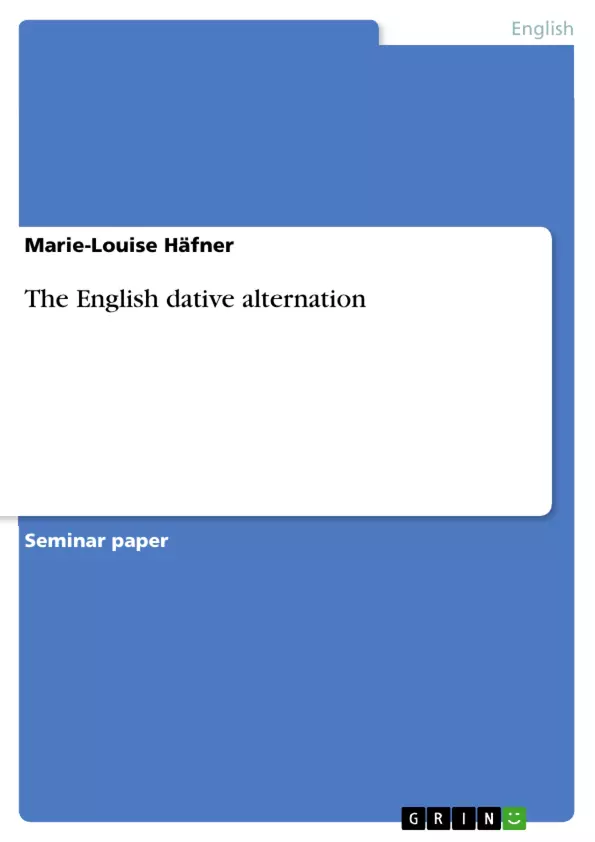Most speakers of English are unconsciously proficient in combining all kinds of information in order to form the grammatical structure they use for language production.
In this essay I attempt to describe one of these complex structures linguistically, namely the nature of dative verbs. Understanding the syntactic patterns of the verb is a challenging task – not only for the acquisition of English as a second language, but for linguistic research just as much.
We're occupied with transitive verbs that take more than one internal argument.There is a great number of alternations in English grammar which do not involve a change in the transitivity of the verb (Levin 1993), one of them being the Dative Alternation, which will be the topic of this essay.
I will begin by introducing some general findings of research in this field whereupon a list of verbs will follow which presents groups of verbs that do or do not perform the alternation.
At the core of my dissertation I will compare two different approaches on the subject, namely the works of Manfred Krifka and Rappaport Hovav & Levin. They represent two sites of the debate concerning the semantics of the dative alternation. Whilst the former defends the so-called polysemy view, the latter are enthusiastic for the single meaning approach. I will go into more detail in section 4.
In the final analysis I'm going to introduce a brief study of the dative alternation in different variants of English, namely British, Australian and American English.
Inhaltsverzeichnis (Table of Contents)
- 1. Introduction
- 2. The Dative Alternation
- 3. Distribution of verbs
- 4. Comparison between
- 4.1 Krifka, M. 2004 and
- 4.2 Rappaport Hovav, M. & Levin, B. 2008
- 5. Distributional differences between the Dative Alternation in different variants of the same language
- 6. Conclusion
Zielsetzung und Themenschwerpunkte (Objectives and Key Themes)
This essay aims to provide a linguistic description of the dative alternation in English grammar, specifically focusing on the syntactic patterns of dative verbs. The essay analyzes the differences between the double object construction and the prepositional indirect-object construction, exploring various research perspectives and contrasting different semantic interpretations of the alternation.
- Syntactic patterns of dative verbs
- Differences between double object construction and prepositional indirect-object construction
- Semantic interpretations of the dative alternation
- Comparison of different theoretical approaches
- Analysis of distributional differences across language variants
Zusammenfassung der Kapitel (Chapter Summaries)
- 1. Introduction: This chapter introduces the topic of dative verbs and the dative alternation in English grammar, highlighting the complexity of understanding the syntactic patterns involved. It sets the stage for the subsequent analysis by outlining the scope of the essay and the different perspectives to be explored.
- 2. The Dative Alternation: This chapter provides a comprehensive overview of the dative alternation, defining the two main syntactic patterns: the double object construction and the prepositional indirect-object construction. It analyzes the role of different constituents in the constructions and discusses the concept of transitivity.
- 3. Distribution of verbs: This chapter focuses on the distribution of verbs that exhibit the dative alternation, exploring the characteristics and patterns of verbs that allow one or both constructions. It provides insights into the linguistic factors that influence the choice of construction.
- 4. Comparison between Krifka, M. 2004 and Rappaport Hovav, M. & Levin, B. 2008: This chapter delves into the comparison of two prominent theoretical approaches to the dative alternation. It contrasts the polysemy view defended by Krifka and the single meaning approach advocated by Rappaport Hovav & Levin, analyzing their respective interpretations of the semantic differences between the two constructions.
Schlüsselwörter (Keywords)
This essay focuses on key concepts such as dative alternation, argument structure, syntactic patterns, double object construction, prepositional indirect-object construction, semantic interpretations, transitivity, polysemy, single meaning approach, and language variation.
- Citation du texte
- Marie-Louise Häfner (Auteur), 2013, The English dative alternation, Munich, GRIN Verlag, https://www.grin.com/document/272007



